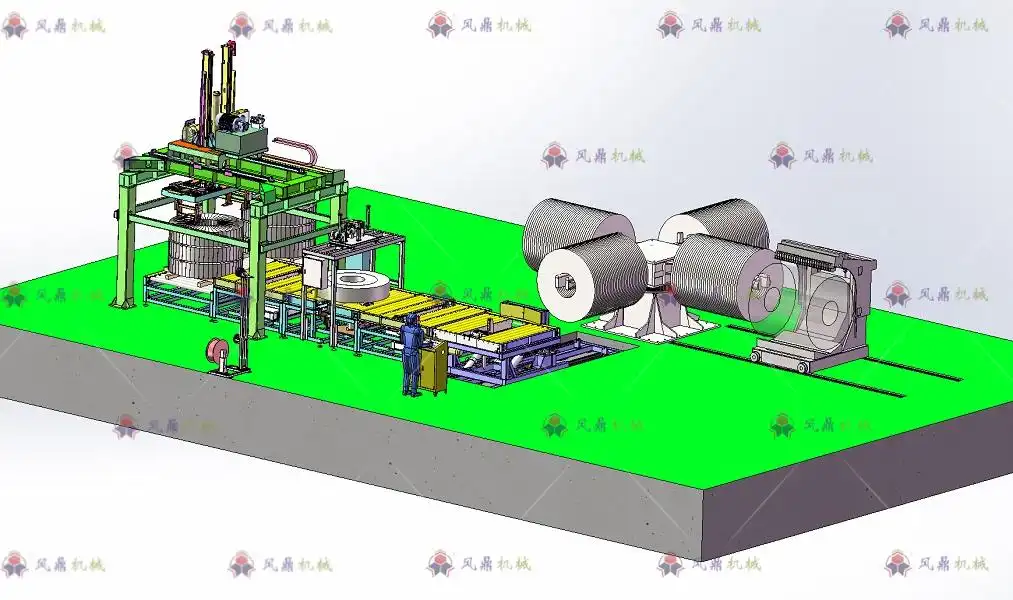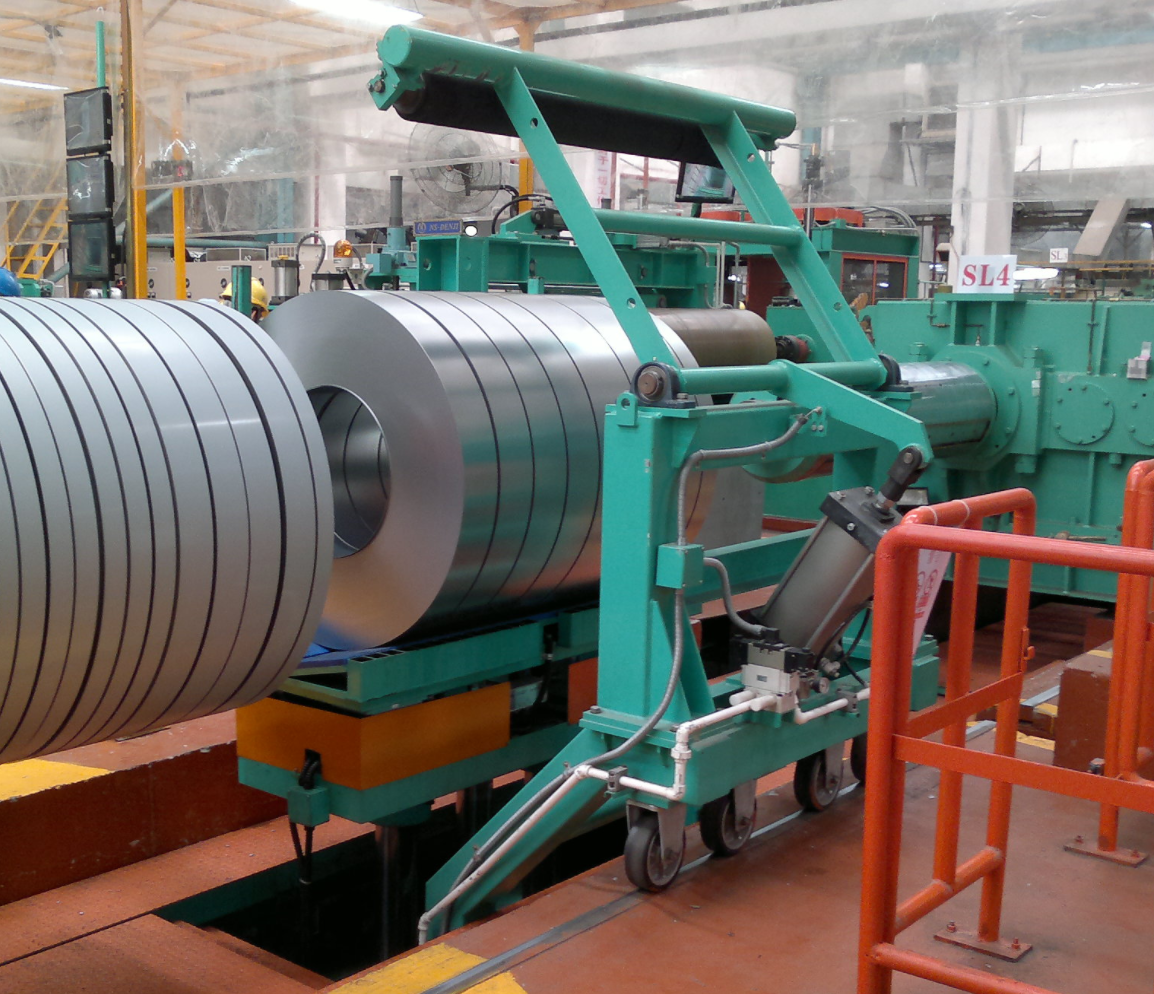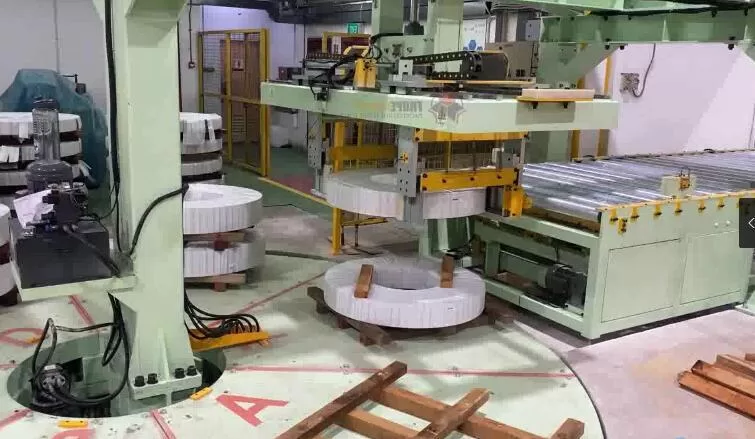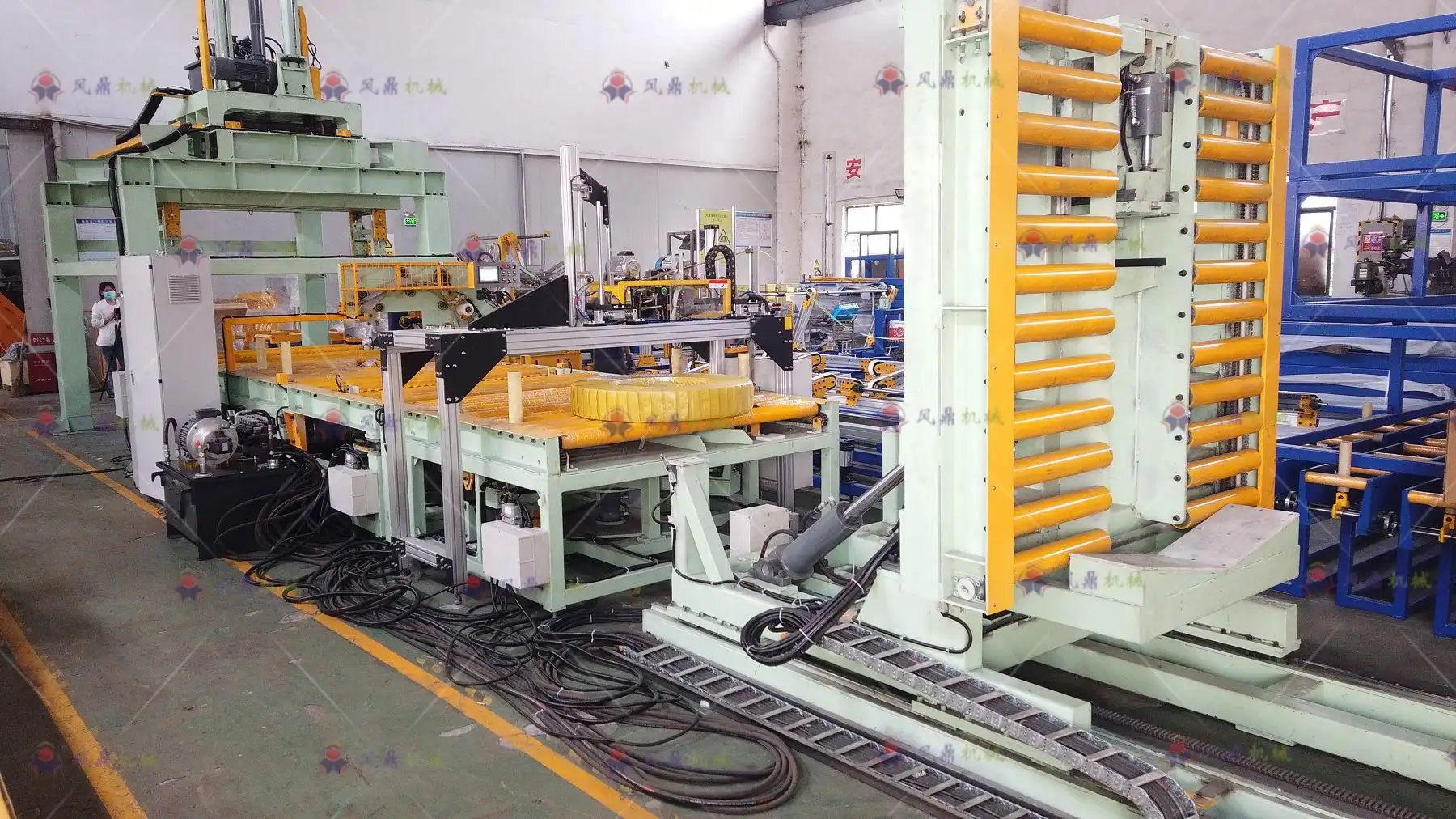Are you managing a steel service center in India? You likely face constant pressure to process and ship slit coils faster. But your current packaging methods, whether manual or using outdated equipment, are a major bottleneck. They are slow, they put your workers at risk, and they often lead to product damage, especially on the sensitive edges of the coils. Every single coil that gets damaged is a potential customer complaint and a hit to your bottom line. Every minute your line is down because of inefficiency is lost revenue. You are constantly worried about the safety of your team as they handle these heavy, dangerous loads. What if you could find the perfect packaging line configuration, one designed specifically for the types of steel grades you handle and the unique challenges of the Indian market? A solution that could boost your speed, protect your product quality, and make your workplace dramatically safer.
The best slit coil packaging line configuration for Indian steel grades directly depends on your production volume, coil specifications, and budget. For most low-to-medium volume service centers, a semi-automatic line featuring a coil car, a coil upender, and a wrapping station provides the best balance of efficiency, safety, and cost. For high-volume operations or those with aggressive growth plans, a fully automatic line that integrates strapping, wrapping, weighing, and stacking is essential to eliminate bottlenecks and maximize throughput.

I have walked through countless steel plants and service centers over my career. I've seen the challenges firsthand. Choosing the right equipment is not just about buying a machine from a catalog. It's about designing a system that solves your specific problems and fits seamlessly into your production flow. It’s an investment in your factory's future. Let’s look at the different options in detail. This will help you understand what you truly need and allow you to make a decision that will pay dividends for years to come.
How Does a Basic Semi-Automatic Line Address Core Needs?
Your team is probably handling heavy slit coils by hand or with basic cranes. This work is slow and physically draining. More importantly, it is a significant safety hazard in your plant. You worry about your workers getting injured from the strain or from an accident. This manual process is almost certainly the biggest bottleneck that is holding back your entire operation and preventing you from increasing your output. A basic semi-automatic line is designed to solve these exact problems. It introduces key pieces of machinery to take over the most difficult and dangerous tasks, providing an immediate and noticeable improvement.
A semi-automatic line addresses these core needs by automating the most critical and physically demanding steps of the packing process. It typically uses a coil car to safely transport coils from the slitter to the packing station and a coil upender or tilter to orient the coil for wrapping. This simple automation drastically reduces the need for manual handling of heavy loads. It significantly improves worker safety and increases packing speed without the much larger capital investment required for a fully automatic system.

Diving Deeper into Semi-Automatic Solutions
When I started my own factory, we began with a process that was far too manual. I remember the anxiety of watching my team lift and move heavy materials. The first major upgrade I invested in was a semi-automatic system, and it changed everything. The relief was immediate, not just for me, but for my entire team. Let's break down why this is such an effective first step.
Key Components of a Semi-Automatic Line
A semi-automatic line is not a single machine but a combination of stations that work together. The core components usually include:
- Coil Car: This is a simple, robust vehicle that runs on a track. It receives the slit coil directly from the slitter's turnstile. This eliminates the dangerous overhead crane maneuver over a person's workspace. The operator can safely move a coil weighing several tons with the push of a button.
- Coil Upender/Tilter: Once the coil is at the packing area, it needs to be turned from a vertical (eye-to-sky) position to a horizontal (eye-to-wall) position for wrapping. An upender does this automatically. It's a huge safety improvement, as manually flipping coils is one of the highest-risk activities in a steel plant.
- Wrapping Station: This is where the coil is wrapped with protective material like VCI paper, stretch film, or HDPE fabric. In a semi-automatic setup, the operator places the packaging material, and the machine rotates the coil to wrap it evenly and tightly. This is much faster and provides a more consistent, protective wrap than doing it by hand.
The Immediate Impact on Safety and Efficiency
The biggest and most immediate return from a semi-automatic line is in safety. You are fundamentally changing the job by removing the most dangerous tasks. Efficiency is a close second. While it still requires an operator to manage the process, you are automating the slowest parts of the job.
| Metric | Fully Manual Process | Semi-Automatic Process | Improvement |
|---|---|---|---|
| Time to Pack One Coil | 15-20 minutes | 5-7 minutes | ~65% faster |
| Required Labor | 2-3 workers | 1 worker | 50-67% reduction |
| Risk of Injury | High | Low | Drastically reduced |
| Package Quality | Inconsistent | Consistent & Professional | Improved protection |
I once worked with a client in Gujarat who was hesitant about the cost. His team was packing coils manually. After we installed a basic semi-automatic line, he called me a month later. He told me his output had increased by 30%, but more importantly, he could finally sleep well at night, not worrying about a serious accident on the factory floor. That is the real power of this upgrade. It is the perfect starting point for most small to medium-sized service centers.
When Should You Upgrade to a Fully Automatic Packaging Line?
Perhaps you already have a semi-automatic line. It served you well and helped you grow. But now, you are facing new problems. Your production volume has increased so much that your packing station is once again the bottleneck. Orders are piling up, and you are struggling to meet delivery deadlines. You might notice that your competitors are shipping their products faster than you can. Your company's growth is no longer limited by your ability to produce steel, but by your ability to package and ship it. This is the clear signal that it's time to consider the next step. A fully automatic packaging line is designed to solve this exact problem by removing the remaining manual steps and creating a seamless, high-speed, integrated process.
You should upgrade to a fully automatic packaging line when your production volume consistently overwhelms the capacity of your current system. This upgrade becomes essential when you need to eliminate human-dependent steps to achieve maximum consistency and speed. A fully automatic line is the right choice when you need to operate 24/7 with minimal downtime, achieve the highest possible throughput to match a high-speed slitter, and integrate your packaging data directly with your factory's management and inventory systems.

Diving Deeper into Full Automation
Making the leap from semi-automatic to fully automatic is a major decision. It requires a significant investment, but the payoff can be transformative for a growing business. I've guided many clients through this transition. It's often the key that unlocks their next level of growth, allowing them to take on larger contracts and compete on a bigger scale. Let's explore what this upgrade truly involves.
Key Differences: Semi-Auto vs. Fully Auto
A fully automatic line takes all the components of a semi-automatic system and connects them with conveyors. It also adds new automated stations to handle tasks an operator would normally do. The goal is a "hands-off" process from the slitter to the warehouse. Key additions include:
- Automated Conveyor System: This replaces the coil car for moving coils between stations. It creates a continuous flow.
- Automatic Strapping Machines: These are the heart of the system. There are two main types:
- Through-the-Eye Strapping: A machine automatically feeds steel or PET straps through the center of the coil and seals them. This is crucial for securing the coil.
- Circumferential Strapping: Another machine applies straps around the outside circumference of the coil to hold the protective wrap in place.
- Automatic Weighing and Labeling: An integrated scale weighs the finished coil, and a printer automatically applies a detailed label with weight, customer info, and a barcode. This eliminates manual errors and is vital for inventory management.
- Stacking and Palletizing: At the end of the line, a robotic arm or mechanical stacker can automatically place the finished coils onto a pallet, ready for shipping.
The Tipping Point for an Upgrade
How do you know you've reached the tipping point? It comes down to data and operational pain.
- Cycle Time Mismatch: Your slitter can produce a new set of coils every 5 minutes, but your packing station takes 10 minutes. This mismatch means your most expensive machine is sitting idle half the time.
- Volume Demands: You are consistently running extra shifts just for packing, or you are turning down orders because you cannot meet the delivery schedule.
- Quality & Data Integrity: You are experiencing issues with inconsistent package quality or errors in shipping due to manual weighing and labeling. You need a system that connects directly to your ERP for 100% accuracy.
A factory manager in Maharashtra, similar to Michael, faced this exact problem. His company had just won a large contract with an automotive manufacturer that required just-in-time delivery. His semi-automatic line simply couldn't keep up. The risk of missing a delivery was too high. We designed a fully automatic line for him. The investment was large, but six months later, his throughput had doubled. He was not only meeting the new contract's demands but also had the capacity to take on more high-volume clients. The investment paid for itself in under two years.
What are the Key Customization Options for Indian Steel Mills?
You understand that a standard, "one-size-fits-all" machine probably won't be a perfect fit for your factory. Every steel mill is different. Your coils have specific widths and diameters. Your factory floor has a unique layout and potential space limitations. And you have to deal with the specific environmental conditions in India, like high humidity. Buying a machine that doesn't account for these factors is a recipe for frustration. It can lead to inefficient operation, constant downtime for adjustments, and the hidden costs of modifying the equipment on-site. The best suppliers don't just sell you a machine; they work with you. They offer key customizations to design a packaging line that fits your operation perfectly.
The key customization options for Indian steel mills focus on three main areas: handling a wide variety of steel grades and coil sizes, providing superior protection against corrosion in humid climates, and integrating seamlessly with your existing factory layout and infrastructure. This means offering adjustable coil handling systems, incorporating VCI paper or film applicators directly into the line, and designing solutions like pit-type conveyors or turntables to make the line fit your space, not the other way around.

Diving Deeper into Customization
From my experience, customization is not a luxury; it is a necessity. This is where a true solution provider separates themselves from a simple equipment seller. A seller will try to make their standard machine fit your problem. A partner will build a solution around your problem. For the Indian market, I've found a few areas of customization are consistently critical for success.
Adapting to Diverse Coil Specifications
Indian service centers often handle a very wide range of products, from narrow coils for small components to wide coils for automotive panels. Your packaging line must be flexible enough to handle this range without long changeover times.
- Adjustable Centering Arms: As the coil moves into the wrapping or strapping station, mechanical arms should automatically center it. These need to be designed to handle your full range of outer diameters.
- Variable Width Conveyors: If you handle both narrow and wide coils, the conveyors and rollers must be able to support them safely. For very narrow coils, special V-shaped rollers or side supports might be needed to prevent them from tipping.
- Flexible Strapping Heads: The "through-the-eye" strapper needs to be able to move to accommodate different coil widths, ensuring the strap is always placed correctly for maximum stability.
Protecting Coils in the Indian Climate
Corrosion is a huge enemy of steel, and the high humidity in many parts of India accelerates it. A freshly slit coil is highly vulnerable. Just wrapping it in plastic is not enough.
- Integrated VCI Application: The most effective customization is to build a VCI (Volatile Corrosion Inhibitor) paper or film dispenser directly into the wrapping station. As the coil is wrapped with stretch film, the machine simultaneously applies a layer of VCI paper. This releases a harmless vapor that creates a protective molecular layer on the steel's surface, preventing rust. This is a massive value-add for your customers and can be a key selling point.
- HDPE Fabric Wrapping: For extra durability and water resistance, especially during monsoon season, an additional wrapping head for woven HDPE fabric can be integrated.
Layout and Infrastructure Integration
| No two factories have the same floor plan. A good packaging line needs to fit your space. | Customization Option | Benefit | Why it Matters in India |
|---|---|---|---|
| Pit-Type System | The line is installed in a pit, making the conveyor level with the factory floor. | Safer for forklift and personnel traffic. Ideal for factories with limited overhead crane access. | |
| 90-Degree Turntables | Allows the direction of the coil flow to change. | Solves layout challenges where a straight line is not possible. Maximizes use of available space. | |
| Integration with MES/ERP | The line's control system communicates with your factory's main software. | Automatic data transfer for inventory, production tracking, and quality control. Crucial for modern, data-driven manufacturing. |
I remember a project in Chennai where the client had a long, narrow space available. A standard line wouldn't fit. We designed a custom U-shaped line using two turntables. It fit the space perfectly and allowed for a much more logical workflow. This kind of problem-solving is what turns a machine purchase into a real solution.
How Do You Calculate the ROI for a New Packaging Line?
You are a plant manager or an operations director, just like my client profile for Michael. You can see the operational benefits of a new packaging line. But to get approval for a large capital investment, you need to speak the language of the finance department. Simply saying "it will be faster and safer" is not enough. You need to present a clear, data-driven business case. If you can't show a solid Return on Investment (ROI), your proposal will likely be rejected. You'll be left to struggle with your old, inefficient, and unsafe process while your competitors move ahead. A well-prepared ROI calculation is the most powerful tool you have. It translates operational improvements like speed and safety into the financial terms that decision-makers care about: cost savings, increased revenue, and profitability.
To calculate the ROI for a new packaging line, you must first determine the total investment cost and then quantify the annual financial benefits. The core formula is ROI (%) = (Annual Net Gain / Total Investment Cost) x 100. The Annual Net Gain is calculated by adding up all the new savings (like reduced labor and product damage) and additional profits (from increased throughput) and then subtracting the new annual operational costs of the machine (like power and maintenance).

Diving Deeper into the ROI Calculation
When I was building my own factory, every single investment had to be justified. I had to be my own CFO. This taught me to be rigorous about calculating ROI. It's not just an academic exercise; it's the foundation of a smart business decision. Let's walk through the process step-by-step, so you can build a case that is impossible to ignore.
Step 1: Identify All Costs (The "Investment")
The total investment is more than just the price on the quotation. To be credible, you must include everything.
- Machine Cost: The base price of the packaging line.
- Shipping & Insurance: The cost to transport the equipment to your factory in India.
- Installation & Commissioning: The cost for the supplier's engineers to install the line and get it running.
- Training: The cost to train your operators and maintenance staff.
- Facility Modifications: Any costs for concrete work (like a pit), electrical upgrades, or compressed air lines.
- Initial Spare Parts: A recommended package of critical spare parts.
A realistic total investment cost shows you've done your homework.
Step 2: Quantify the Returns (The "Return")
This is the most critical part. You need to assign a real monetary value to each benefit.
- Labor Savings: This is the easiest to calculate. Let's say the new line allows you to reassign 2 workers per shift, and you run 2 shifts. Calculate their total annual cost:
(Number of Workers) x (Annual Salary + Benefits). - Increased Throughput Profit: This is your biggest gain. If the new line lets you pack 20 extra coils per day, and your net profit per coil is ₹5000, the calculation is:
(Extra Coils per Day) x (Operating Days per Year) x (Profit per Coil). - Reduced Product Damage: Look at your records. How much money did you lose last year to coils damaged during packing and handling? This is a direct saving. If you were scrapping ₹1,000,000 worth of material, a new line could reduce that by 90%. That's a ₹900,000 saving.
- Reduced Packaging Material Waste: An automatic wrapper uses a precise amount of stretch film, often less than manual wrapping. This can add up to significant savings.
Step 3: A Sample Calculation
Let's put it into a table. Imagine a semi-automatic line investment.
| Item | Amount (in INR) | Notes |
|---|---|---|
| A. Total Investment Cost | ₹8,000,000 | Includes machine, shipping, installation |
| --- | --- | --- |
| B. Annual Savings & Gains | ||
| Labor Savings | ₹1,200,000 | 2 workers x 2 shifts reassigned |
| Increased Throughput Profit | ₹4,500,000 | 15 extra coils/day x 300 days x ₹1000 profit/coil |
| Reduced Product Damage | ₹800,000 | Reduced scrap/rework |
| C. Total Annual Gain (B) | ₹6,500,000 | |
| --- | --- | --- |
| D. Annual Operating Costs | (₹500,000) | Power, maintenance, consumables |
| E. Annual Net Gain (C - D) | ₹6,000,000 | |
| --- | --- | --- |
| ROI (E / A x 100) | 75% | |
| Payback Period (A / E) | 1.33 Years |
When you present a table like this, the conversation changes. It's no longer about spending money. It's about making a strategic investment with a clear, predictable, and very attractive return.
My Insights: Beyond the Machine, It's About the Partnership
I've spent my entire career in this industry. I started as an engineer on the factory floor. I know the feeling in your stomach when a production line stops. I remember the long hours and the frustration of dealing with equipment that didn't work as promised. Later, I took the biggest risk of my life and built my own packing machine factory. I've been in your shoes, and I've been in the shoes of the equipment builder.
This journey taught me something profound. When a plant manager like Michael Chen is looking for a solution, he is not just buying steel and motors. He is buying a result. He is buying less stress, a safer factory, and the ability to grow his business. He's looking for a partner who understands this. I know the distrust he feels. I've also dealt with suppliers who make big promises before the sale and then disappear when you need support. It’s a terrible experience, and it costs you more than just money; it costs you time and trust.
This is why my mission with SHJLPACK is different. When a client from India or Mexico calls me, our conversation starts with their problems, not my machines. We talk about the specific grades of steel they are slitting. We discuss the humidity in their region and the best way to prevent rust. We talk about their truck loading process and how the packaged coils need to be staged for efficient dispatch. We look at their factory layout and figure out the smartest way to integrate a new line.
A true partner understands that the packaging line is just one part of a larger process. It has to receive coils from the slitter efficiently and hand them off to the logistics team seamlessly. The solution has to work in the real world, not just on a blueprint.
My goal is not simply to sell a wrapping machine. My goal is to share the knowledge I was so fortunate to gain. I want to help you avoid the costly mistakes and find the path to a safer, more efficient, and more profitable operation. When my clients succeed, I feel like I have succeeded too. That is the foundation of a real partnership.
Conclusion
Choosing the right slit coil line is a critical strategic decision. Focus on your specific needs, carefully calculate the financial return, and most importantly, find a partner who understands your world.





